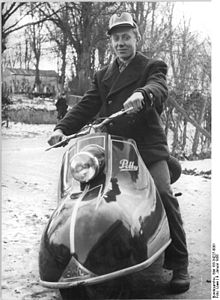IWL Pitty
| IWL | |
|---|---|
 IWL Pitty (1956) |
|
| Pitty | |
| Manufacturer | VEB Industriewerke Ludwigsfelde |
| Production period | 1955 to 1956 |
| class | Scooter |
| Motor data | |
| Single-cylinder two-stroke - gasoline engine | |
| Displacement (cm³) | 123 cc |
| Power (kW / PS ) | 3.8 kW |
| Top speed ( km / h) | 65 km / h |
| transmission | 3-speed |
| drive | Chain |
| Empty weight (kg) | 140 |
| successor | IWL SR56 Wiesel |
The Pitty was a motor scooter model in the GDR . It was built from February 1955 to April 1956 as the first motor scooter in VEB Industriewerke Ludwigsfelde . The two-seater scooter has an originally from the MZ blank 125 /1 Pedigree forming fan-cooled 123 cc engine (RT 125/1 M) with 5 horsepower. The maximum speed is 65 km / h. The model was built 11,293 times by 1956. Its successor is the Wiesel model .
history
At the beginning of the 1950s there was the first scooter boom, which began with the successful Piaggio models . After some companies in the FRG had jumped on this trend, the voices of those who wanted a scooter in the GDR increased . In the centrally controlled economy , it was initially difficult to choose a suitable construction for series production. As early as 1950, the master craftsman August Falz was involved in the construction of motor scooter test vehicles , which he called Falzo . His scooters had interesting structural details, such as a hand lever instead of a kick starter. One of his Falzo types was presented at the Leipzig trade fair and probably also produced on a smaller scale. It is not clear why it did not come to mass production. Another designer was preferred - Max Freihoff , who, as the founder of the first PGH of metalworking, was favored by the government. The planned series transfer of his scooter Hexe failed due to conceptual deficiencies such as the buckling suspension - a construction that was comfortable, but allowed the scooter to buckle in the middle under load. As a result, a collective of engineers and skilled workers was put together to present a test vehicle within 81 days - punctually for the birthday of the late Stalin on December 21, 1953. The pitty came out. The series transfer announced for summer 1954 was to be delayed until February 1955. In the meantime, August Falz has already built the modern Sibylle scooter , but this progressive design was not transferred to series production either. The pitty was first seen at the Leipzig trade fair in spring 1955
properties
The very high power to weight ratio of 37 kg / kW in connection with the 3-speed gearbox meant that insufficient performance was often criticized. The fuel tank held 8 liters, so that with an average consumption of 3.5 l / 100 km, the range was just 228 km. The suspension was designed to be quite soft. Quite strong vibrations occurred between 45 and 50 km / h. The pleasing cladding was laborious to manufacture and devoured large quantities of the deep-drawn sheets, which were difficult to obtain. There were also cracks in the rear of the fairing. The Piccolo Trumpf motorized hospital elevator is in some ways similar to the Pitty due to the identical front panel. In addition, a type Tula-200 was built in the Soviet Union , which was outwardly very similar to the Pitty.
Test reports
- The first 1000 kilometers with the "Pitty". In: Automobiltechnik Heft 9/1955, pp. 317-318.
See also
Web links
Individual evidence
- ↑ automotive technology 9/1951, p 221st
- ↑ automotive technology 10/1953, pp 319-320.
- ↑ automotive technology 7/1953, S. 229th
- ↑ News from the Pitty scooter. In: Motor vehicle technology 2/1954, p. 62.
- ↑ New "Sibylle" folding motor scooter. In: Motor vehicle technology 7/1954, p. 220.
- ↑ photo report from the Technical Leipzig 1955. In: Automotive Engineering 5/1955, S. 146th
- ↑ Damage to the body of the "Pitty" scooter. In: Motor vehicle technology 1/1956, p. 31.
